Fritter
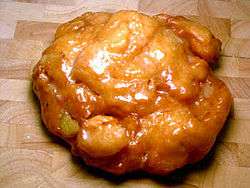 An apple fritter | |
| Type | Pastry |
|---|---|
| Main ingredients | Batter |
A fritter is a fried food usually consisting of a portion of batter[1][2] or breading which has been filled with bits of meat, seafood, fruit,[3] vegetables or other ingredients.[4][3] Fritters are prepared in both sweet and savory varieties.[4]
Varieties
China
Throughout China, fritters are sold at roadsides. They may contain pork, but are commonly vegetarian.
India
Fritters are extremely popular roadside snacks all over South Asia and are commonly referred to as pakora (pakoda) or bhajji (bhajia) in local parlance—the onion bhaji also enjoys a high popularity abroad and at home. In the south Indian state of Kerala, Banana Fritters are extremely popular and are known as Pazhampori (പഴംപൊരി).
 A woman making bajjis in Mylapore
A woman making bajjis in Mylapore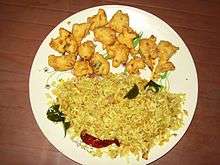 Uggani bajji; rice and fritters, typical breakfast from Rayalaseema.
Uggani bajji; rice and fritters, typical breakfast from Rayalaseema.
Indonesia
In Indonesia fritters come under the category of gorengan (Indonesian: fritters, from goreng "to fry"), and many varieties are sold on travelling carts or by street vendors throughout Indonesia.[5] Various kinds of ingredients are battered and deep fried such as pisang goreng (banana fritter), tempeh, mendoan, tahu goreng (fried tofu), oncom, sweet potato, cassava chunk, cassava tapai, cireng (tapioca fritters), bakwan (flour with chopped vegetables) and breadfruit.[6] And these are often eaten accompanied by fresh bird's eye chili. The variety known as bakwan commonly contains flour with chopped vegetables such as carrot and cabbage, whereas the fried patties called perkedel typically consist of mashed potatoes or ground corn (perkedel jagung or bakwan jagung).
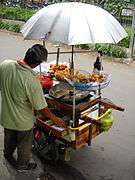 Gorengan, Indonesian assorted fritter street vendor
Gorengan, Indonesian assorted fritter street vendor- Indonesian tempeh and tofu fritters
 Bakwan jagung, Indonesian corn fritter
Bakwan jagung, Indonesian corn fritter
Iran
The Iranian variety is called Kuku which come in different versions like the ones with potatoes or the ones with herbs.This type of fritter resembles a crustless quiche.
- Kuku-sabzi
Japan
In Japanese cuisine, tempura is vegetable or seafood dipped and fried in a light crispy batter and served as a common accompaniment to meals.
Korea
In Korean cuisine, deep-fries are known as twigim (튀김). Twigim are often battered and breaded, but there are varieties without breading, as well as varieties without breading and batter. Popular twigim dishes include dak-twigim (fried chicken), gim-mari-twigim (fried seaweed roll), goguma-twigim (fried sweet potato), gul-twigim (fried oyster), ojingeo-twigim (fried squid), and saeu-twigim (fried shrimp).
Traditional vegetarian deep-fries associated with Korean temple cuisine include twigak and bugak.[7] Twigak are made from vegetables such as dasima (kelp) and bamboo shoot, without breading or batter. Bugak are made from vegetables such as dasima, perilla leaves, and chili peppers, which are coated with glutinous rice paste and dried thoroughly.

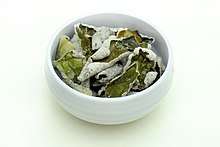
 Miyeok-twigak (seaweed fries)
Miyeok-twigak (seaweed fries)
Malaysia
In Malaysia and Brunei, it is common for a type of fritter called "cucur"[8] (such as yam, sweet potato and banana[9]) to be fried by the roadside[9] in a large wok and sold as snacks.
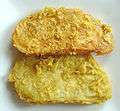 Malaysian roadside yam and sweet potato fritters
Malaysian roadside yam and sweet potato fritters
Myanmar
In Burmese cuisine, fritters are called a-kyaw (Burmese: အကြော်), while assorted fritters are called a-kyaw-sone (Burmese: အကြော်စုံ). The most popular a-kyaw is the gourd fritter (ဘူးသီးကြော်). Diced onions, chickpea, potatoes, a variety of leafy vegetables, brown bean paste, Burmese tofu, chayote, banana and crackling are other popular fritter ingredients. Black beans are made into a paste with curry leaves to make bayagyaw[10]—small fritters similar to falafel. Unlike pisang goreng, Burmese banana fritters are made only with overripe bananas with no sugar or honey added.
The savory fritters are eaten mainly at breakfast or as a snack at tea. Gourd, chickpea and onion fritters are cut into small parts and eaten with Mohinga, Myanmar's national dish. These fritters are also eaten with Kao hnyin baung rice and with Burmese green sauce—called chin-saw-kar or a-chin-yay. Depending on the fritter hawker, the sauce is made from chili sauce diluted with vinegar, water, cilantro, finely diced tomatoes, garlic and onions.
 Fried snacks of Myanmar
Fried snacks of Myanmar
New Zealand
Whitebait fritters are popular in New Zealand.[11]
- New Zealand whitebait fritters
Philippines
In the Philippines, egg fritters are called kwek-kwek (quail) or tokneneng (chicken), and squid fritters are called kalamares. These, along with shrimp fritters called okoy, and banana fritters called maruya are also sold in travelling cart or street side vendors.
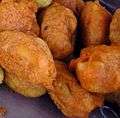 Kwek-kwek (quail egg fritters)
Kwek-kwek (quail egg fritters)
South Africa
Pumpkin fritters, served with cinammon sugar at any time of day, are popular in South Africa.[12][13]
Thailand
 Nam phrik kapi served with vegetable fritters; a common dish in Thai cuisine
Nam phrik kapi served with vegetable fritters; a common dish in Thai cuisine
United Kingdom
In British fish and chip shops, the fish and chips can be accompanied by "fritters", which means a food item, such as a slice of potato, a pineapple ring, an apple ring[14] or chunks, or mushy peas, fried in batter. Hence: "potato fritter", "pineapple fritter", "apple fritter", "pea fritter", etc. At home and at school, fritters are also sometimes made with meat, especially Spam and corned beef.
 Banana fritters
Banana fritters
United States
In the United States, fritters are small cakes made with a primary ingredient that is mixed with an egg and milk batter and either pan-fried or deep-fried; wheat flour, cornmeal, or a mix of the two may be used to bind the batter. "Corn fritters" are often made with whole canned corn and are generally deep-fried. "Apple fritters" are well known, although the contemporary American apple fritter is unlike the British one. Older versions of the apple fritter in the United States were prepared in the style of British ones, by slicing apples, dipping them in batter and frying them.[15] Another regional favourite is the "zucchini fritter".
Africa
West African countries have many variations similar to fritters. The most common process includes the blending of peeled black eyed beans with peppers and spices to leave a thick texture. A Yoruba version, Akara, is a popular street snack and side dish in Nigerian culture
See also
References
- ↑ Grand Diplome Cooking Course. Taylor & Francis US. p. 58. Retrieved November 5, 2016.
- ↑ Co., Royal Baking Powder (2009). The Royal Baker and Pastry Cook. Wildside Press. p. 7. ISBN 978-1-4344-5495-9. Retrieved November 5, 2016.
- 1 2 Gisslen, W. (2004). Professional Baking. Wiley. p. 189. ISBN 978-0-471-46427-3. Retrieved November 5, 2016.
- 1 2 Shields, D.S. (2015). Southern Provisions: The Creation and Revival of a Cuisine. University of Chicago Press. p. 158. ISBN 978-0-226-14125-1. Retrieved November 5, 2016.
- ↑ Kraig, Bruce; Sen, Colleen Taylor (2013-09-09). Street Food Around the World: An Encyclopedia of Food and Culture. ABC-CLIO. ISBN 9781598849554.
- ↑ Fauziah (2017-06-02). "Gorengan: Indonesia's Favorite Fried Snacks - Indoindians". Indoindians. Retrieved 2018-06-27.
- ↑ Koehler, Robert (2010). Korea Foundation, ed. Traditional Food: A Taste of Korean Life. Korea Essentials. 4. Seoul: Seoul Selection. ISBN 978-1-62412-036-7. Retrieved 1 March 2018.
- ↑ Musa, N. (2016). Amazing Malaysian: Recipes for Vibrant Malaysian Home-Cooking. Random House. p. 90. ISBN 978-1-4735-2366-1. Retrieved November 5, 2016.
- 1 2 Albala, K. (2011). Food Cultures of the World Encyclopedia. Food Cultures of the World Encyclopedia. Greenwood. p. 161. ISBN 978-0-313-37626-9. Retrieved November 5, 2016.
- ↑ Marks, C.; Thein, A. (1994). The Burmese Kitchen: Recipes from the Golden Land. M. Evans. p. 35. ISBN 978-1-59077-260-7. Retrieved November 5, 2016.
- ↑ Bloom, A.; Wechter, E.B. (2010). Fodor's New Zealand. Fodor's New Zealand. Fodor's Travel Publications. p. 53. ISBN 978-1-4000-0841-4. Retrieved November 5, 2016.
- ↑ "Rainbow cooking:Pumpkin fritters (pampoenkoekies)".
- ↑ "Tasty Recipes for SA People:Pumpkin fritters".
- ↑ Raffald, E. (1808). The experienced English house-keeper, consisting of near 800 original receipts. p. 118. Retrieved November 5, 2016.
- ↑ Verstille, E.J. (1812–1876). Verstille's Southern Cookery. American Antiquarian Cookbook Collection. American Antiquarian Society. p. 168. ISBN 978-1-4494-3629-2. Retrieved November 5, 2016.
External links

